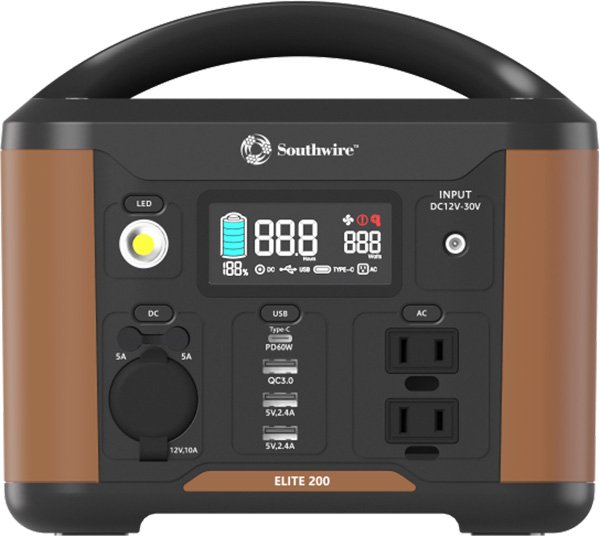
If you buy something through our links, ToolGuyd might earn an affiliate commission.
Southwire announced new portable power stations on social media late last year, describing them as delivering “power wherever, whenever.”
Shown above, the Southwire Elite 200 battery power station (53250) has a 222 watt-hour battery and delivers a Sine Wave output to 2 AC outlets. It has 4 USB ports, a built-in LED light with SOS function, and can power a 32″ TV for as long as 4 hours.
The power station can be charged via auto DC outlet, solar panel (not included), AC wall outlet, or USB PD. Two more charging methods – AC via generator, and AC + USB C PD – provide for what Southwire describes as “an industry best” 6 ways to charge.

It can be used to charge or power your drone, phone, laptop, mini fridge, LED work light, camera, speaker, CPAP machine, or slow cooker.
Digging through the online user manual, this Southwire power station can deliver 120V AC at up to 200W. That’s just 1.67A.
They have other sizes of portable power stations.

The Southwire Elite 1100 series portable power station can handle more, such as blenders and griddles. According to the online user manual, it has a 1166.4 watt-hour battery and can deliver 120V AC at up to 1000W (8.3A).

Duracell has their own portable power stations of a similar design, advertising them as “backup portable power pack for power outages, emergency kits, home electronics, and outdoor use.”

Klein announced a 500W power station last year, KTB500.
The Klein KTB500 has a 505 watt-hour battery and can deliver pure sine wave AC power up to 500W continuous and 1000W surge. It has 2 AC outlets, 4 USB ports, and a 12V auto DC port.
Klein says that this power station was “designed with the jobsite in mind” and that it:
provides power to electronic devices and mid-power corded tools in a lightweight portable device that is a better alternative to loud, exhaust emitting gas generators.
They recently got back to me about the types of equipment it can power, saying:
4.2A is still perfectly capable of running smaller tools and powering smaller devices. Fans, battery chargers, laptops, phones, and small handheld drills are some examples of devices that can be powered by the KTB500.
The KTB is a highly portable power source that doesn’t require you to fill it up with gas, nor do you have to worry about noxious fumes or noise. In that light, I find it to be an alternative to gas generators that fits many more use cases that gas generators can’t.

There are larger consumer-focused portable power stations as well, such as the Anker PowerHouse 767, which has 2048 watt-hour of battery capacity and can deliver up to 2000W of power.
The downside is that it’s the size of a small gas engine generator.
So, here’s my question. Are these types of products useful or practical for tool users? If you’re a contractor, tradesperson, technician, or other such professional, would you bring a portable power station like these to your jobsite?
The concept isn’t new. Anker – a company that specializes in mobile device charging products – launched their first product of this kind nearly 7 years ago. Bosch launched a large mobile battery bank 7-1/2 years ago in Europe.
Milwaukee has a new M18 power supply that works with their cordless power tool batteries, and launched their Top-Off compact adapter 2-1/2 years ago. The Top-Off is limited to 175W AC output, and the M18 power supply a full 15A.
I can see the benefit of a small power station for charging the increasing number of small tools and personal electronics with built-in batteries. But are smaller power stations, which cost several hundred dollars each, a practical solution?
On one hand, nothing short of 15A/1800W continuous power seems very practical to me. On the other hand, power stations capable of 15A AC output at 120V require a lot of energy storage capacity. Bigger batteries mean higher cost, larger size, and greater weight.
You don’t need 1800W of continuous and 3600W surge pure sine wave AC power output to charge a laptop, tablet, or digital meters.
Some corded power tools can be powered by a couple of hundred watts of power, and certainly the same could be said of worklights and small fans.
I find solutions that work with off-the-shelf cordless power tool batteries to be convenient. But, smaller units with built-in batteries might also be convenient for lighter needs.
Such products seem more tailored towards outdoor recreational use than for the workshop or jobsite, and yet tool brands seem very intent to describe them as potential gas generator replacements.
All of the many smaller power stations out now, whether by Southwire, Klein, or the multitude of consumer brands, are smaller, simpler, and focused on low-wattage and USB charging. Many of the smaller units can also be charged by different means, including optional solar panels.
Is there a sweet spot with regard to capabilities?
If you’re already onboard, which brand have you used and could recommend?
If you’re hesitant, what would it take for you to be convinced?
Brands and Products Discussed in this Post
Buy the Duracell at Amazon
Buy the Klein at Acme Tools
Buy the Klein at Home Depot
Buy the Southwire at Acme Tools
Buy Anker at Amazon






